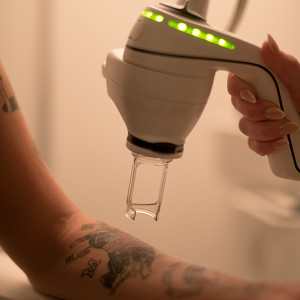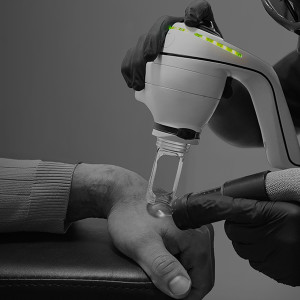
Red tattoo ink has a bad rep for being unsafe. But is it justified?
One of the important factors that impact how long it takes to remove a tattoo is the type of ink used in the tattoo design. But there is little agreement throughout the tattoo community on the rules and regulations pertaining to different tattoo inks. Guidelines in Europe differ from those in the US, for instance. So it can be difficult to know exactly what sort of ink makes up your unique tattoo design.
Fortunately, academic research is being done to get a better understanding of coloured inks and their properties, as well as how they impact a person’s health. We spoke to Matthew Kiszla, M.D. Candidate at the University of Alabama at Birmingham Heersink School of Medicine, about his fascinating research into tattoo inks and how they play a role in laser tattoo removal.
At NAAMA our expert tattoo removal consultants say that red ink can sometimes be the first colour to go during a course of treatments. The LightSense™ laser system uses different wavelengths to treat different colours of ink. So what’s the truth about different coloured tattoo inks and how they respond to laser tattoo removal?
Why do you think it is difficult for people to become informed about tattoo inks before they visit a tattoo studio?
I personally believe that there is a paucity of data. The lack of information about adverse reactions to tattoos simply available to the public plays a major role in this difficulty. However, a fair amount of work on the part of the customer really does go into looking for a tattoo artist - what they're looking for is tattoo artists with experience.
I see tattoo artists themselves as having the expert role, at the moment, on a lot of potentially problematic inks. They have amassed a wealth of great anecdotal evidence throughout their careers. So, I do believe that many tattooed individuals choose their artists carefully. At this point, that's the best one can do for independent research on the side of the customer.
In terms of that research, surveys on complications are few and far between. Estimates of the frequency of the types of adverse reactions that we are more worried about on our side of the research can vary widely.
Hopefully one day customers will be able to choose inks based on estimates of the risk of the product causing adverse reactions and how much risk the customer is willing to accept. In anticipation of that day, we thoroughly encourage anyone suffering from such a reaction to report it and seek care.
Why is red ink particularly problematic when it comes to tattoos?
The short answer is, at this point, we simply do not know. Historically, red tattoo inks were coloured with cinnabar, or mercury sulphide, with their adverse reactions of course being attributed to that mercury content.
Now, however, we know that these red inks are being coloured with entirely different agents, which are typically organic rather than metallic salts. These agents are known as azo dyes or as azoic compounds - in reference to their key double bonds between two nitrogen atoms.
Even today, red tattoo inks continue to be thought of as the most problematic. However, there are other warm-hued colourants that involve azo dyes. So, what differentiates the red azo dyes from the yellows? Their structures look quite similar on paper. Understanding why reds might be a little bit more problematic requires more research.
It should be noted that red tattoo ink is more popular than yellow. So, we are also in the midst of differentiating these rates of adverse reactions by simple popularity versus actual risk by colour.
What harm can metallic pigments do to the body when they are injected into the dermis?
We are just beginning to understand the way that tattoo inks settle within the body.
We do know that in the layers of the skin where ink deposits are densest, “burns” can actually develop when the metals used in inks interact with the magnetic fields generated by MRIs.
Additionally, we do know that tattoo inks do not only settle within skin, but they may also travel to regional lymph nodes as well. When metals in inks do so, they can appear as calcifications on mammograms, which is something that radiologists are looking for when they're trying to detect breast cancers. Beyond false positives in cancer screenings, however, the risks are yet to be determined.
We must wonder about the systemic risks posed by heavy metals circulating throughout the body in more heavily tattooed individuals.
What are the options for tattoo lovers in terms of organic dyes?
Although the classic reactions to tattoo inks were secondary to their metal content, people certainly are still suffering from reactions to their tattoos today. Analysis across multiple studies has shown that the concentrations of these different metals and metalloids are beginning to normalize across the different colours, implying that they remain as contaminants. Blues and greens do still involve a significant amount of copper and nickel. However, for the warm hues, which seem to be involved in more adverse reactions, the relative lack of metallic salts points toward the organic colourants themselves - those azo dyes or azoic compounds - as the cause.
We believe that the same reaction that causes those warm-hued tattoos to begin to fade in strong sunlight is probably the same reaction that's driving a lot of our adverse reactions. The splitting of those fundamental azo bonds, which can be catalysed by ultraviolet radiation, can release more reactive chemicals.
The adverse reactions that we're facing are on a spectrum from minor itching and irritation, which seem somewhat common especially in the summer, all the way up to effects that are long term and even disfiguring. Reactions can be quite severe, though perhaps rarely.
What do we know about how lasers respond to different types of tattoo ink?
The treatment of tattoos by laser has come a long way in recent years. We are at the point of being able to optimize the removal of tattoos by their colour, often using different lasers to target different colours of ink.
The background research that we're doing right now, talking about ink formulation as organic versus inorganic, is helpful in the process moving forward. We do want to note that our work, regarding tattoo removal, is based off some predictions and so some trial and error may be required.
While the treatment of non-complicated tattoos appears to be progressing nicely, there is much further room for the treatment of tattoos with adverse reactions.










